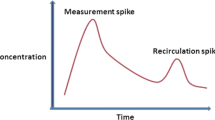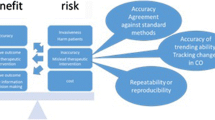Abstract
Less invasive cardiac output monitors have been developed as alternative to thermodilution-based cardiac output measurements from pulmonary artery catheters. These include Doppler-based methods, bioimpedance and bioreactance, pulse contour analysis, partial rebreathing, and pulse wave velocity. Currently available technologies differ in their underlying physical principles but also in their risks and accuracy of measurements. While less invasive devices are appealing for clinical use and have clinical utility, further studies are needed to determine their ability to positively impact meaningful patient outcomes.
Access this chapter
Tax calculation will be finalised at checkout
Purchases are for personal use only
Similar content being viewed by others
Suggested Reading
Aars H. Diameter and elasticity of the ascending aorta during infusion of noradrenaline. Acta Physiol Scand. 1971;83(1):133–8.
Benatar SR, Hewlett AM, Nunn JF. The use of iso-shunt lines for control of oxygen therapy. Br J Anaesth. 1973;45(7):711–8.
Bernstein DP. A new stroke volume equation for thoracic electrical bioimpedance: theory and rationale. Crit Care Med. 1986;14(10):904–9.
Boehmer RD. Continuous, real-time, noninvasive monitor of blood pressure: Penaz methodology applied to the finger. J Clin Monit. 1987;3(4):282–7.
Chaney JC, Derdak S. Minimally invasive hemodynamic monitoring for the intensivist: current and emerging technology. Crit Care Med. 2002;30(10):2338–45.
Gan TJ, Soppitt A, Maroof M, el-Moalem H, Robertson KM, Moretti E, et al. Goal-directed intraoperative fluid administration reduces length of hospital stay after major surgery. Anesthesiology. 2002;97(4):820–6.
Greene ES, Gerson JI. Arterial pulse wave velocity: a limited index of systemic vascular resistance during normotensive anesthesia in dogs. J Clin Monit. 1985;1(4):219–26.
Gurgel ST, do Nascimento Jr P. Maintaining tissue perfusion in high-risk surgical patients: a systematic review of randomized clinical trials. Anesth Analg. 2011;112(6):1384–91.
Hamilton W, Remington J, Dow P. The determination of the propagation velocity of the arterial pulse wave. Am J Physiol. 1945;144:521–35.
Hamilton MA, Cecconi M, Rhodes A. A systematic review and meta-analysis on the use of preemptive hemodynamic intervention to improve postoperative outcomes in moderate and high-risk surgical patients. Anesth Analg. 2011;112(6):1392–402.
Haryadi DG, Orr JA, Kuck K, McJames S, Westenskow DR. Partial CO2 rebreathing indirect Fick technique for non-invasive measurement of cardiac output. J Clin Monit Comput. 2000;16(5–6):361–74.
Imholz BP, Wieling W, van Montfrans GA, Wesseling KH. Fifteen years experience with finger arterial pressure monitoring: assessment of the technology. Cardiovasc Res. 1998;38(3):605–16.
Ishihara H, Okawa H, Tanabe K, Tsubo T, Sugo Y, Akiyama T, et al. A new non-invasive continuous cardiac output trend solely utilizing routine cardiovascular monitors. J Clin Monit Comput. 2004;18(5–6):313–20.
Jaffe MB. Partial CO2 rebreathing cardiac output–operating principles of the NICO system. J Clin Monit Comput. 1999;15(6):387–401.
Keren H, Burkhoff D, Squara P. Evaluation of a noninvasive continuous cardiac output monitoring system based on thoracic bioreactance. Am J Physiol Heart Circ Physiol. 2007;293(1):H583–9.
Kubicek WG, Kottke J, Ramos MU, Patterson RP, Witsoe DA, Labree JW, et al. The Minnesota impedance cardiograph-theory and applications. Biomed Eng. 1974;9(9):410–6.
McGrath SP, Ryan KL, Wendelken SM, Rickards CA, Convertino VA. Pulse oximeter plethysmographic waveform changes in awake, spontaneously breathing, hypovolemic volunteers. Anesth Analg. 2011;112(2):368–74.
Nugent AM, McParland J, McEneaney DJ, Steele I, Campbell NP, Stanford CF, et al. Non-invasive measurement of cardiac output by a carbon dioxide rebreathing method at rest and during exercise. Eur Heart J. 1994;15(3):361–8.
Nyboer J. Electrical impedance plethysmography; a physical and physiologic approach to peripheral vascular study. Circulation. 1950;2(6):811–21.
Starling EH. The Linacre lecture on the law of the heart. London: Longmans, Green, & Company; 1918.
Summers RL, Shoemaker WC, Peacock WF, Ander DS, Coleman TG. Bench to bedside: electrophysiologic and clinical principles of noninvasive hemodynamic monitoring using impedance cardiography. Acad Emerg Med. 2003;10(6):669–80.
Swan HJ, Ganz W, Forrester J, Marcus H, Diamond G, Chonette D. Catheterization of the heart in man with use of a flow-directed balloon-tipped catheter. N Engl J Med. 1970;283(9):447–51.
Thiele RH, Colquhoun DA, Patrie J, Nie SH, Huffmyer JL. Relationship between plethysmographic waveform changes and hemodynamic variables in anesthetized, mechanically ventilated patients undergoing continuous cardiac output monitoring. J Cardiothorac Vasc Anesth. 2011;25(6):1044–50.
Author information
Authors and Affiliations
Corresponding author
Editor information
Editors and Affiliations
Rights and permissions
Copyright information
© 2014 Springer Science+Business Media New York
About this chapter
Cite this chapter
Thiele, R.H., Bartels, K., Gan, T.J. (2014). Noninvasive Cardiac Output Monitoring. In: Ehrenfeld, J., Cannesson, M. (eds) Monitoring Technologies in Acute Care Environments. Springer, New York, NY. https://doi.org/10.1007/978-1-4614-8557-5_9
Download citation
DOI: https://doi.org/10.1007/978-1-4614-8557-5_9
Published:
Publisher Name: Springer, New York, NY
Print ISBN: 978-1-4614-8556-8
Online ISBN: 978-1-4614-8557-5
eBook Packages: MedicineMedicine (R0)




